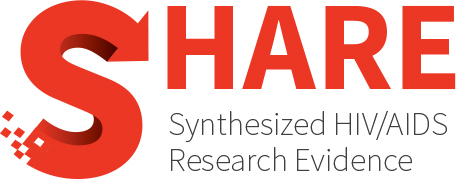Category Archives: Linkage/engagement in care
The HIV care cascade in sub-Saharan Africa: Systematic review of published criteria and definitions
INTRODUCTION: The HIV care cascade examines the attrition of people living with HIV from diagnosis to the use of antiretroviral therapy (ART) and suppression of viral replication. We reviewed the...
Evidence regarding rapid initiation of antiretroviral therapy in patients living with HIV
PURPOSE OF REVIEW: Rapid initiation of antiretroviral therapy (ART) is increasingly more common among clinics serving people living with human immunodeficiency virus (PLWH). It is recommended by major guidelines and...
HIV self-testing uptake and intervention strategies among men in Sub-Saharan Africa: A systematic review
Background: HIV testing is an essential gateway to HIV prevention and treatment services. However, HIV testing uptake remains low among men due to stigma, discrimination, and confidentiality concerns. HIV self-testing...
Barriers to the management of children under five exposed to HIV in the rural areas of South Africa
BACKGROUND: South Africa has made enormous progress in reducing mother-to-child transmission (MTCT) of human immunodeficiency virus (HIV), however, MTCT and AIDS related death persist among children particularly in the rural...
A narrative systematic literature review: A focus on qualitative studies on HIV and medication-assisted therapy in the United States
Over the last two decades, the United States (U.S.) has experienced an opioid crisis that has had a significant negative societal and economic impact. Due to the high utilization of...
Adherence to HIV care and associated health functioning among youth living with HIV in Sub-Saharan Africa
Older adolescents and young adults (youth) living with HIV (YLH) in sub-Saharan Africa (SSA) are at high risk for poor HIV treatment adherence and associated negative health outcomes including viral...
Stigma, HIV risk, and access to HIV prevention and treatment services among me who have sex with mem (MSM) in the United States: A scoping review
In light of recent advances in HIV prevention and treatment, we reviewed the literature to understand how different types of stigma impact HIV risk; access to HIV prevention, care, and...
Comparing the effects of HIV self-testing to standard HIV testing for key populations: A systematic review and meta-analysis
BACKGROUND: We update a previous systematic review to inform new World Health Organization HIV self-testing (HIVST) recommendations. We compared the effects of HIVST to standard HIV testing services to understand...
What do we know about patient-provider interactions in sub-Saharan Africa? A scoping review
INTRODUCTION: patient-centred care has become a rallying call for improving quality and access to care in countries where health system responsiveness and satisfaction with health services remain low. Understanding patient-provider...
